“This is a practical oriented course so there cannot be any other way of judging talen except through practical work. As 80% is practical work, by the time students reach the fourth and final year, most have been groomed into well trained young artists. It becomes very difficult to judge these artists and 100% marking need not always be a fair judgement of the real acumen of that artist!”
- Tejendra Singh Baoni

An illustrious voyage of art and artists, the College of Fine Arts (CFA) under the aegis of the Karnataka Chitrakala Parishath (CKP) is a living ‘canvas’ to almost all generations of art lovers and connoisseurs. The celebrated college within the Karnataka Chitrakala Parishath complex precincts, is a landmark site in the heart of Bengaluru’s Kumara Krupa Road, adjoining the CM’s residence and is nothing less than a haven for artists. Its glorious yet humble beginnings dates back some 50 years, and the story of the institute is also the story of determination and doggedness of its founder-teachers-pioneer artists, all who strode on to create an environment that would nurture the very spirit of artistic freedom under one roof. An autonomous institution for fine arts, and affiliated to the Bangalore University (BU) since 1983; the fine arts college is also a learning centre recognised by the state and the national Lalit Kala Akademi (academy of art) since 1966.
The vision which started as a single room entity between 1960 and 1964, found momentum in 1964 due to the zeal and passion of M S Nanjunda Rao, an astute artist and the Founder Secretary of the CKP. The fine arts college took shape in 1964 on the top floor of Gandhi Sahitya Sangha as ‘Chitrakala Vidyalaya’ on 8th Cross Malleshwaram, a north-western neighbourhood in the garden city. At a rental room of Rs. 100 per month, eminent artists such as M S Nanjunda Rao, M Gopal, S S Kukke, Rajshekahar and Subramanya Raju, encompassed the first batch of teachers who conducted the then five year diploma course in an honorary position ‘sans’ salary. With 8-9 students in its first batch, one of the first recipients of the diploma was a young woman, M J Kamalakshi, who has since served as professor of painting and also as the general secretary of the CKP and Principal of the art college in later years. A renowned artist, Nanjunda Rao, donned on the hat of an art administrator and along with founder President, R M Murthy, envisioned setting up the art institute to attain world-class stature. He realised that Karnataka lacked a strong platform for artists, and dared to dream of a larger prominent centre of art akin to the Delhi Art College and Institute of Fine Arts, Shantiniketan (West Bengal). He was the one who expressed the idea to the then ministers and approached higher-ups to procure land for the institute. He served as the Principal of the college until the 1990s as well as the Secretary for the CKP. The ‘heart and soul’ of CKP; he is remembered as a soft spoken, yet a persistent individual.

CKP is a landmark visual cultural centre in Bengaluru and the State of Karnataka. Socially prominent individuals such as B L Shankar as President of the Executive Committee of CKP along with A Ramakrishnappa as Vice President and other leading personalities add to CKP’s glorious existence. The CKP also gains from the presence of its eminent Trust Committee member President S M Krishna and Vice President H K Kejriwal and other illustrious personalities such as Kiran Majumdar Shaw, P Dayananda Pai, D K Chowta and Sudha V Reddy, to name a few of the reputed line-up that has helped herald the CKP and the Chitrakala Mahavidyalaya within its precincts.
The college and CKP is gearing up for yet another milestone as it prepares to spread its canvas across 14 acres on a new prototype campus site, at Ganakal village near Kengri, Bengaluru. The land granted by the Government of Karnataka will be designed as an ancillary residential and professional learning space built to international scale. The State Government has reserved an outlay of Rs. 20 crores for the construction of this additional new campus.

Corporate Citizen spoke to Prof Tejendra Singh Baoni, Principal - College of Fine Arts, Karnataka Chitrakala Parishath – a Fullbright Scholar, and an acclaimed sculptor in visual arts for the past 32 years, who has been associated with the college since 1987. Born in Rewa in a traditional family of court artists, Baoni completed his Bachelor in Fine Arts (BFA) in 1985 and Master in Fine Arts (MFA) in 1987 in sculpture art at Kalabhavan, Vishwabharati University, Shantiniketan, West Bengal. He then pursed his post doctorate degree in sculpture at the Kent Institute of Art and Design, Canterbury, UK. His esteemed colleague, former Principal and much accomplished artist (traditional painting) and creative thinker - Kamalakshi, also an alumni provided valuable inputs on the historical and present mileages —adding that her innings and associations with the college and the Parishath stands a “little over 50 years”.
Both Baoni and Kamalakshi, have won many individual laurels, but expressed their passion for art and the fine arts college; each thriving a bit further to pass on their learning to the next gen. They along with Ramakrishnappa, discussed the historical beginnings of the college and its role in bridging tradition with modern artistic visages and the influence of applied art in modern times
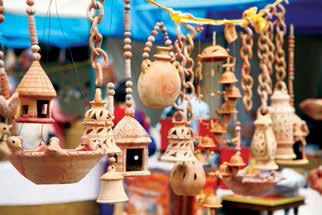
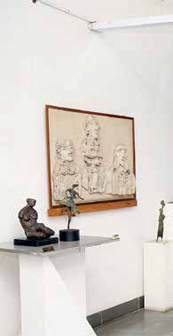
Ramakrishnappa: It is said that the foundation for a fine arts college began in the 1960s with a call from the then Chief Minister of the Mysore State, Kengal Hanumanthiah, who during the construction of the Vidhana Soudha building had called for a tender for artistic contribution. Ironically, as most applicants were artists from outside Karnataka, he was surprised at the lack of home-grown applicants from the state. He is believed to have summoned M Aryamurthy, a senior artist and urged him to form a forum of artists. Aryamurthy is said to have established the Mysore Pradesh Chitrakala Parishath from his residence in Shantinagar, which was registered in 1968. Meanwhile, they started the one-room Chitrakala Vidyalaya in 1964 in Malleshwaram. Thanks to the efforts of Nanjunda Rao (M S N Rao) and fellow artistes, the vidyalaya moved to its current site in 1976. The team of artistes along with M S N Rao chose a three acre thicket next to the Chief Minister’s bungalow; today well recognised as the land next to Hotel Ashoka in Bengaluru on Kumara Krupa Road. They conveyed their interest in developing an arena for fine arts and indigenous craft to the then CM, Devaraj Urs. It is learnt that the site had been earmarked to house a driver’s quarters as it was within the precincts of the CM’s residence and guest house. Eventually, the then Chief Secretary and the Joint Secretary of the State-T P Issar and Chiranjiv Singh also convinced CM Urs to release land for the formation of the CKP in its current site. In 1976-77, the CKP Trust with eminent personalities was formed and the Mysore Pradesh Chitrakala Parishath transitioned and was re-named as the Karnataka Chitrakala Parishath. The idea was now to start the course as an affiliation with some university as BFA and MFA. The process to get an affiliation with the BU started immediately in 1978-79.
Kamalakshi: As we transitioned to the entity - Karnataka Chitrakala Parishath (CKP), we also did get the land; but, now needed to make the new art arena popular. So, an All India Tribal Arts and Crafts Exhibition was hosted for 45 days in January 1977 to attract people to the new premises. Post the exhibition, the huts built were converted into classrooms and eventually the building, a museum, a gallery built. Until then, classrooms were in the open and rocks were used as tables and chairs for our students.
“Earlier it was a ‘ guruku - lam ’ method of teaching but things have changed gradu - ally. Now, we have embedded it with modern technology and in the future, we antici - pate much more contrasts in classic work. Need is to flow with the change. Sometime people might get inspired by earlier work but interpret and create an entirely new work of art; much different from academic styles. My advice is in adopting earlier techniques and utilising it in your contemporary styles. ...Adaptation is important and then again, it depends on individual experience and liking”...
-M J Kamalakshi
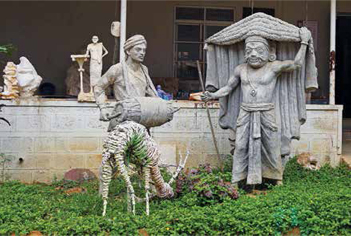
Kamalakshi: The government has provided cer - tain infrastructure for setting and running of the CKP. It in fact granted the land on long lease; some portions of which was sanctioned for con - struction of the building. However, many philan - thropists too donated funds and other resources, thereby forming a trust and some even became part of the trustee member panel of the CKP. There have been other non-trustee members who have donated to the cause of the CKP. As for the arts college, the Parishath is taking care of the college and is the main organisation. From its beginnings, the Parishath has been running the art institution – the ‘Chitrakala Vidyalaya’ and once it gained affiliation to the Bangalore Uni - versity (BU) in 1983, it came to be known as the ‘Chitrakala Mahavidyalaya’.
Kamalakshi: The Parishath is actually running the college. While the fee components help us to run the college, it is not sufficient for the entire college expenditures. Besides, this and the DT E (Directorate of Technical Education) compo - nent towards paying salary, the remaining has to be covered by the management – the Parish - ath is the college management. We are auton - omous for academic matters, the rest is vested under the Parishath’s umbrella mantle. The trustee committee is the caretaker of the whole institution and is responsible for the vast asset held by the CKP and the CFA. The trust is the engine that runs the college, along with upkeep of the art museums within our premises and the vast collection of world-class art, artefacts and paintings within our hold. Trustees are taking responsibility of all these assets and holdings. CKP trust is the common body between the college and the Parishath. The trust members include art lovers, politicians and artists who take care of the assets and can intervene in the wake of any disputes etc.

Kamalakshi: When the ‘Chitrakala Vidyalaya’ started in 1964, it ran and awarded a five year diploma course for interested students post their Secondary School Leaving Certificate (SSLC) examinations. Those days the examination was conducted by the Education Board and not the University and for this reason we got affiliated to the BU. We are currently running an UG as well as PG courses. The college was getting a nominal allowance from the DPI (Department of Public Instruction), for schools in Karnataka. It was I guess, around Rs. 500 to Rs. 1000 in the 1980s. We did not come under any eligibility criteria for re - ceiving any grant or aid. Later, we did get some ad hoc aid from the state government’s Depart - ment of Kannada and Culture, which was not at all sufficient. Gradually, we got affiliated to the DTE. Currently, the DTE is paying only the staff salary, while 80% of other expenses continue to be funded and managed by the CKP Trust.
Baoni: Currently the CFA is an autonomous in - stitute. We are expecting the third cycle of auton - omy now. Since the last 10 years we have been autonomous, this was followed by the next stage which will cover another 15 years and we hope to acquire a deemed university status too in the near future.

Baoni: The college offers degrees in UG and PG levels in five major disciplines - Sculp - ture, Painting, Graphic Art (film-making), Art History, Applied Art and Print Making. For the master’s programme too, CFA offers art disciplines which are comparable to that of Kala Bhavan, Shantiniketan’s Institute of Fine Arts or the Faculty of Fine Arts at the Maharaja Sayajirao University in Baroda, the College of Art, (under Delhi University) and to some of the international academies such as the Royal Academy of Arts, London. Courses are run as per UGC norms so they run for four years for the degree programme and another two years for the PG levels. It is a 4+2 years coursework as against the earlier 5+2 structure. The PhD research programme commenced recently in the last academic session (2016-17) encouraging students to explore pre-modern and modern art on Kar - nataka and pan-Indian subjects.
Baoni: Yes. In the four years degree pattern, stu - dents can also move to other streams for three weeks per semester. Each year comprises of two semesters and you need to qualify a total eight semesters over four years. The spread over the first two semesters covers all five disciplines - Sculpture, Painting, Print Making, Illustrations and Applied Art. Thus, we give them a taste of all kinds of visual art forms and enable them to choose their discipline for specialisation. Stu - dents have to opt for their desired specialised visual form from the third semester. Besides, after each semester after the foundation year, we enable inter-disciplinary training.
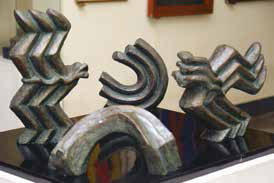
Baoni: After the first two semesters, the college conducts internal counselling sessions to gauge their aptitude for any particular course disci - pline. While, we primarily give them freedom of choice to select their line of specialisation; we also do suggest on what discipline can suit them best. Once they undergo inter-disciplinary training, they are better placed to take a decision on their specialised subjects in the future. Students who are specialised in applied art or painting are thus enabled to excel in sculpture forms too. As a profession, we have observed that students specialised in sculpture making have excelled in interior designing too; which is not part of our coursework. Likewise, such training prepares them for their Masters training too.

Baoni: Our course work is so inclusive and varied that we have seen some of our students taking to film-making too (which is not a part of our syllabus). Because of the nature of fine art training at CFA, they are also equipped and can adapt to other technology platforms and infuse creativity and engage in, video art work too. Video art also forms a part of fine art in modern times. Some students thus can lead themselves towards film-making or any other performing art. So, via the five disci - plines, we aim to nurture their knowledge quotient to the extent that they are capable of adapting themselves to any discipline. We have an example of a student, last year who bagged a national award in film-making — having majored in painting and art history. The possibilities are innumerable. Some of our alumni are film directors, interior design - ers, and even architects. Our coursework en - courages and trains but, it is all to do with cre - ativity. So, it is left to the students how they apply their knowledge in their chosen stream.How they do it is often difficult to pinpoint in a creative world.
"The increasing importance of art and design in today’s world opens up many opportunities to make an impact and also contribute to the cultural and ecological landscape at both the local and global levels”
- Tejendra Singh Baoni
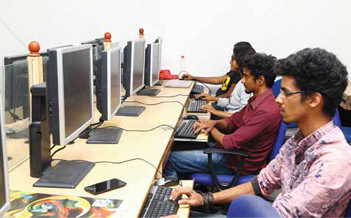
Baoni: Yes. We can intake around 150 seats per year but, we do not clamour to fill all seats. We are interested in students who are committed to visual arts and show ‘real’ artistic bent. Last academic year (2016-17), we had selected 140 students. Currently, more than 400 students are studying at the institute. This academic year, 90 of our final year students will be attaining their degrees.
We do not have to fill all 150 seats; if applicants are not capable to show talent for fine arts in the test itself, we need not select them. We have gradually increased our intake and capped it at 150. However, we will be shortly moving to the new campus and might increase the intake. It depends on the demand for this course and the educational need for such a programme. Admission intake has increased in the last four years. There are 142 students in the current foundation batch of students (2016-17), as against 90 students who will be completing their final year this academic session.

Baoni: Since we follow UGC norms, students have to fulfil the min 55% marks criteria for Grade XII or PUC scores. However, while we select students, we also gauge their strength of character along with their skills and passion for creative challenges. Since it is a creative field, we rather prefer a talented XII grade stu - dent with 55% over a student with a score of 95% and here merit is based on their artistic talent. We have had students from science stream aban - doning their engineering or medical seats and joining the arts college. Students with 95- 96% in grade XII also appear for our entrance tests. This is a practical oriented course so there cannot be any other way of judging talent except through practical work. As 80% is practical work, by the time stu - dents reach the fourth and final year, most have been groomed into well trained young artists. It becomes very difficult to judge these artists and 100% marking need not always be a fair judge - ment to the real acumen of that artist!
Baoni: We have constituted the Board of Educa - tion (BOE) and the Board of Studies (BOS) and function within the purview of these two bodies. These are our own formed bodies which include our own HODs (Head of Departments) and se - nior professors who design the entire syllabus. We try and change it every two years to keep the syllabus relevant. Earlier the syllabus change was meted out every three to four years. The last revi - sion was done in 2014, but now we plan to do it more often and soon. This move is to sync with current requirements of students, the industry and artistic demands in society.
Kamalakshi: Our expert teaching staffs takes a call on reviving the syllabus if needed. We often adopt the latest tools or resources. Earlier, art students were required to compulsorily learn anatomy but presently, we are done with that as part of curriculum. But, if the student needs an understanding of human anatomy, for a specific project, and if necessary then teachers can teach that point but, that need not be part of the exam - ination syllabus. In the good old days, there was no computer. But, nowadays art students rely a lot on animation techniques and thus animation is a new subject which has also been incorporat - ed in the syllabus.
“Our course work is so inclusive and varied that we have seen some of our students taking to film- making too (which is not a part of our syllabus). Because of the nature of fine art training at CFA, they are also equipped and can adapt to other technology platforms and infuse creativity and engage in say, video art work too. Video art also forms a part of fine art in modern times”
- Tejendra Singh Baoni

Baoni: We too have campus placement inter - view for our students where companies like Wi - pro, Honeywell and similar companies absorb them within their creative or marketing depart - ments. While we teach our students creativity, companies train them on how to promote a company via product designs or marketing portfolio. Our students thus have a big demand in the corporate world.
Kamalakshi: If corporate salary is attractive then most students would opt for corporate life. These companies need to also provide job profiles, which for an artist have to be satisfying. Industry profile should also match with artistic acumen for progress in the long-run. Not many students opt for teaching unless they have a lik - ing for sharing knowledge. Those who in applied art and painting join companies as establishing oneself as successful independent and creative artists, which takes a long time; so they opt for corporate jobs.
Kamalakshi: Earlier it was more methodical; we worked around and fixed things but, now we have more scope and technological intervention in art. Present day students have more exposure than and are more aware. There is a change in every field so it is in fine art too. Nowadays, students react to contemporary ideas and artwork rather than the traditional forms. While we do impart knowledge of the old traditional forms, it is also left to the students on how they wish to influence their own art or develop themselves. They may mix up both and create a fusion art form. With the advent of new technology and material as against say only water or oil colours, we also have various mediums to work and experiment with.
Baoni: This is an important annual event, like a street bazaar organised by the Karnataka Chi - trakala Parishath which helps to build a connect between artists, the Parishath and the college with the public. This is also an attempt to break the perceived ‘elitist’ mentality that is often at - tached to ‘art’ and artists for a common person. Hundreds of artists from all over India partici - pate in the ‘santhe’ and sell their artwork at dis -counted price to all. It is a kind of street festival, which lines up the entire Kumara Krupa road by artists who sell their paintings, porcelain art, sculptures and other artefacts. If requested, some artists also offer to draw instant portrait sketches of visiting art enthusiasts to their stalls and bespoke art wares.

Baoni: The increasing importance of art and design in today’s world opens up many oppor - tunities to make an impact and also contribute to the cultural and ecological landscape at both the local and global levels.
Kamalakshi: Earlier it was a ‘ gurukulam ’ meth - od of teaching but things have changed gradu - ally. Now, we have embedded it with modern technology and in the future, we anticipate much more contrasts in classic work. Need is to flow with the change. Sometimes, people might get inspired by earlier work but they interpret and create an entirely new work of art, much different from academic styles. My advice is in adopting earlier techniques and utilising it in your contemporary styles; which is what I am doing in order to also revive traditional styles. Adaptation is important and then again, it de - pends on individual experience and liking.
By Sangeeta Ghosh Dastidar